
The Cantharellaceae are a family of fungi in the order Cantharellales. The family contains the chanterelles and related species, a group of fungi that superficially resemble agarics but have smooth, wrinkled, or gill-like hymenophores. Species in the family are ectomycorrhizal, forming a mutually beneficial relationship with the roots of trees and other plants. Many of the Cantharellaceae, including the chanterelle, the Pacific golden chanterelle, the horn of plenty, and the trumpet chanterelle, are not only edible, but are collected and marketed internationally on a commercial scale.

The Phallales is an order of fungi in the subclass Phallomycetidae.
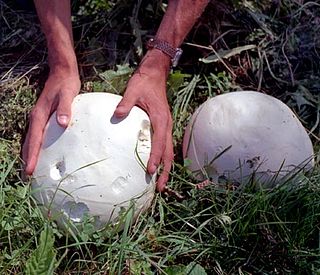
The Lycoperdales are a now outdated order of fungi. The order included some well-known types such as the giant puffball, the earthstars, and other tuberous fungi. They were defined as having epigeous basidiomes, a hymenium present, one to three layers in the peridium, powdery gleba, and brown spores.

Auriscalpium is a genus of mushrooms typifying the family Auriscalpiaceae.

Dothideomycetes is the largest and most diverse class of ascomycete fungi. It comprises 11 orders 90 families, 1,300 genera and over 19,000 known species. Wijayawardene et al. in 2020 added more orders to the class.

The Bondarzewiaceae are a family of fungi in the order Russulales. The type species for both its genus and the family as a whole, Bondarzewia montana, closely resembles members of Polyporales, but has ornamented spores like those of Lactarius or Russula. This characteristic suggested the relationship between physically dissimilar species that eventually led to the restructuring of Russulales using molecular phylogeny. According to the Dictionary of the Fungi, the family contains 8 genera and 48 species.

The Gomphales are an order of basidiomycete fungi. Some or all families belonging to Gomphales have been sometimes included in the order Phallales, the now-obsolete Ramariaceae was also previously included in Cantharellales. Recent phylogenetic analyses include in Gomphales the families of the original description of the order by Walter Jülich, with addition of Clavariadelphaceae. According to one 2008 estimate, the Gomphales contain 18 genera and 336 species.

The Hysterangiales are an order of fungi in the class Agaricomycetes, subclass Phallomycetidae. According to one 2008 estimate, the order contains five families, 18 genera, and 114 species.
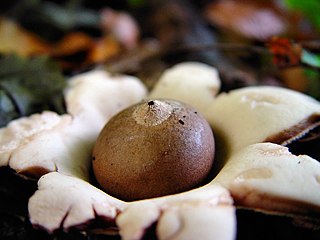
Geastrum is a genus of puffball-like mushrooms in the family Geastraceae. Many species are commonly known as earthstars.

Sphaerobolus is a genus of fungi in the family Geastraceae. Commonly known as the "shotgun fungus", "artillery fungus" or "cannonball fungus", species discharge their spores with explosive force. Discharged spore sacs are sticky and have a tendency to strongly adhere to whatever surface they encounter, making them a nuisance to homeowners, pressure washing contractors, landscape mulch producers and insurance companies.
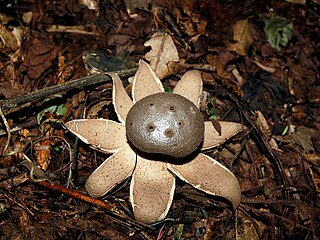
Myriostoma is a fungal genus in the family Geastraceae. Basidiocarps resemble earthstars, but the spore sac is supported by multiple columns and has multiple ostioles instead of a single, apical ostiole. Until 2017, the genus was thought to be monotypic with a single, widespread species, Myriostoma coliforme. Recent research has, however, shown that at least six species occur worldwide.

Geastrum pectinatum is an inedible species of mushroom belonging to the earthstar family of fungi. Although young specimens are spherical, fruit body development involves the outer layer of tissue splitting open like a star into 7 to 10 pointed rays that eventually bend back to point downward, revealing a small – 1 to 2.5 cm broad – spore sac. The spore sac is supported by a small radially wrinkled stalk. There is a distinct conical opening (peristome) at the top of the spore sac that is up to 8 mm long. It is commonly known as the beaked earthstar or the beret earthstar, in reference to the shape of the spore sac and its prominent, protruding peristome. The mass of spores and surrounding cells within the sac, the gleba, is dark-brown, and becomes powdery in mature specimens. Spores are spherical, measuring 4 to 6 micrometers in diameter, with warts on their surfaces.

Astraeus hygrometricus, commonly known as the hygroscopic earthstar, the barometer earthstar, or the false earthstar, is a species of fungus in the family Diplocystaceae. Young specimens resemble a puffball when unopened. In maturity, the mushroom displays the characteristic earthstar shape that is a result of the outer layer of fruit body tissue splitting open in a star-like manner. The false earthstar is an ectomycorrhizal species that grows in association with various trees, especially in sandy soils. A. hygrometricus was previously thought to have a cosmopolitan distribution, though it is now thought to be restricted to Southern Europe, and Astraeus are common in temperate and tropical regions. Its common names refer to the fact that it is hygroscopic (water-absorbing) and can open up its rays to expose the spore sac in response to increased humidity, then close them up again in drier conditions. The rays have an irregularly cracked surface, while the spore case is pale brown and smooth with an irregular slit or tear at the top. The gleba is white initially, but turns brown and powdery when the spores mature. The spores are reddish-brown and roughly spherical with minute warts, measuring 7.5–11 micrometers in diameter.

Astraeus is a genus of fungi in the family Diplocystaceae. The genus, which has a cosmopolitan distribution, contains nine species of earthstar mushroom. They are distinguished by the outer layer of flesh (exoperidium) that at maturity splits open in a star-shape manner to reveal a round spore sac. Additionally, they have a strongly hygroscopic character—the rays will open when moist, but when hot and dry will close to protect the spore sac. Species of Astraeus grow on the ground in ectomycorrhizal associations with trees and shrubs. Despite their similar appearance to the Geastrum earthstars, the species of Astraeus are not closely related.

Geastrum triplex is a fungus found in the detritus and leaf litter of hardwood forests around the world. It is commonly known as the collared earthstar, the saucered earthstar, or the triple earthstar—and less commonly by the alternative species name Geastrum indicum. It is the largest member of the genus Geastrum and expanded mature specimens can reach a tip-to-tip length of up to 12 centimeters.
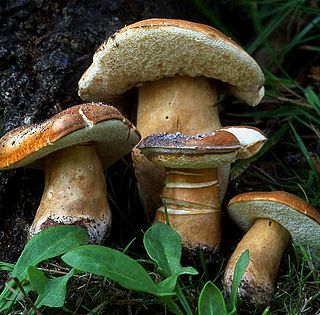
The Gyroporaceae are a family of fungi in the order Boletales. The family is monogeneric, containing the single genus Gyroporus, which, according to a 2008 estimate, contains ten widely distributed species, though a more recent study suggested the species-level diversity to be far higher.

Geastrum jurei is a species of fungus in the Geastrales, or earthstar fungi. It is known only from Algarrobo, in the Valparaíso province of Chile. It is a fornicate species of earthstar, meaning that the tips of the rays press down so as to raise the spherical spore sac into the air.
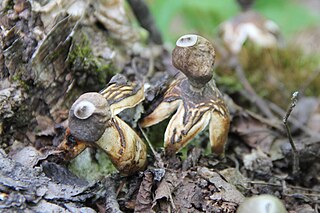
Geastrum quadrifidum, commonly known as the rayed earthstar or four-footed earthstar, is an inedible species of mushroom belonging to the genus Geastrum, or earthstar fungi. First described scientifically by Christian Hendrik Persoon in 1794, G. quadrifidum is a cosmopolitan—but not common—species of Europe, the Americas, Africa, Asia, and Australasia. The fungus is a saprobe, feeding off decomposing organic matter present in the soil and litter of coniferous forests.

Myriostoma coliforme, commonly known as the saltshaker earthstar or pepper pot, is a fungal species in the family Geastraceae. Basidiocarps resemble earthstars, but the spore sac is supported by multiple columns and has multiple ostioles instead of a single, apical ostiole. It has also been called "salt-shaker earthstar". The fungus has a north temperate distribution, but was formerly thought to be more widespread due to confusion with related Myriostoma species. Myriostoma coliforme is an uncommon species and appears on the Red Lists of 12 European countries. In 2004 it was one of 33 species proposed for protection under the Bern Convention by the European Council for Conservation of Fungi.
Kjeldsenia is a fungal genus in the family Claustulaceae of truffle-like species. It was first described in 1995 and in Mendocino County, California. The genus name honors C.K. Kjeldsen, professor of botany at Sonoma State University, while the specific epithet for the type species aureispora refers to the color of the spores when they are viewed in transmitted light.



















